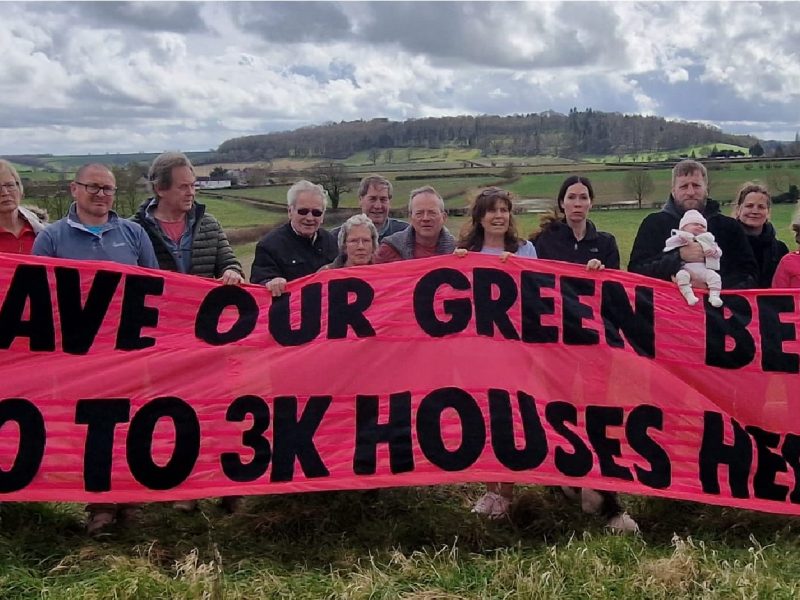GREEN-belt land around Keynsham needs permanent protection from future development, the town council has said.
It was responding to a consultation on the new Local Plan, which will shape the future of home-building and job creation in Bath and North East Somerset until 2042.
Options for new housing mentioned in B&NES Council’s consultation document include 1,500 homes in north Keynsham, 500-750 at Hicks Gate, 350 in south-east Keynsham, 100-300 in west Keynsham, 160 east of Avon Mill Lane and 40-100 in central Keynsham. They also include 800 homes in south Saltford and 500 homes.
In its official response, Keynsham Town Council has asked B&NES Council, as the local planning authority, to “seriously consider the request of Keynsham and Saltford for landscape designation”. This would provide a “more permanent protection” for green-belt land, much of which has already been lost to development.
The town council said: “B&NES Council is apparently willing to surrender Green Belt land to development to meet housing need and not comply with the spirit and intent of the Government’s national planning and environmental policies.”
It said the aim of national green-belt policy is to prevent urban sprawl by keeping land permanently open.
“To remove land from the Green Belt for development in the Local Plan would represent a failure of trust by B&NES Council to the local communities adversely affected.”
The town council said it favoured the creation of sustainable new settlements, stating: “This would be much less harmful overall than the current approach by B&NES Council of the over-developing and ruining of existing settled communities by adding additional housing developments to meet housing targets that put such a strain on local services, congest local roads and remove the last remaining parcels of green space that are so important for residents’ health and wellbeing and local wildlife habitat.”
The town council also argued: “The identified need for new housing going forward is in Bath not Keynsham or near outlying villages. If people are to walk and/or cycle to work, new housebuilding should be where the jobs are.”
Regarding the suggestion for 1,500 new homes in north Keynsham, the town council said the two best options were to build nothing – because of concerns about conservation and flooding – or aim for 2,000 homes of a higher density, possibly by building apartments rather than houses. The latter would need to be supported by “really good” infrastructure.
The town council said it was “very surprised that this proposal includes student accommodation, as the location is totally inappropriate.”
It gave its “partial support” to 160 homes on brownfield land east of Avon Mill Lane, saying “this will bring relief to the much-disturbed nearby residents and resolve potential enforcement issues that are often raised due to current site activities.” But 4Concrete, a company currently based at the site, would need help finding another location to avoid jobs being lost.
The town council was scathing about suggestions to build homes on the Tesco car park and other town centre car parks, saying this would worsen parking problems in the town.
It commented: “You cannot transport the weekly shop for a family on your bike or on a bus.”
It said it was concerned about the prospect of 100 to 300 homes to the west of Keynsham, narrowing the green belt separating the town from Stockwood and resulting in the loss of the Lays Farm industrial estate. But it was partially supportive of building on just part of the identified land.
“Since homes have to be built somewhere, this is one of the least-bad options. However, on the land proposed it should be possible to build more than 100 homes if density were increased.”
It gave its partial support to 350 new homes in south-east Keynsham, welcoming the opportunity to link development with the Manor Road Community Woodland improvement project, but said walking and cycling routes to nearby amenities would need to be significantly improved.
Regarding the suggestion for 500-750 homes at Hicks Gate, the town council warned that “such heavy development will be problematic for the A4” and urged B&NES Council “to be aware of the danger of merging Keynsham and Bristol.” It did, however, say that one of the two options proposed would provide easy access to the A4 for residents and could be combined with industrial uses.
The Local Plan options document includes proposals for a new village of up to 3,000 new homes on land south of Burnett, next to the A39, which have sparked protests from residents who have formed the Burnett and Corston Protection Alliance.
Keynsham Town Council said: “The development of a new residential community in South Burnett is unwelcome in a green valley of agricultural land. The paucity of services and environmental destruction in this location makes it a totally inappropriate location for development.”
To read Keynsham Town Council’s full response to the Local Plan consultation, go to http://www.keynsham-tc.gov.uk/_VirDir/CoreContents/News/Display.aspx?id=69233
Pictured, members of the Burnett and Corston Protection Alliance


